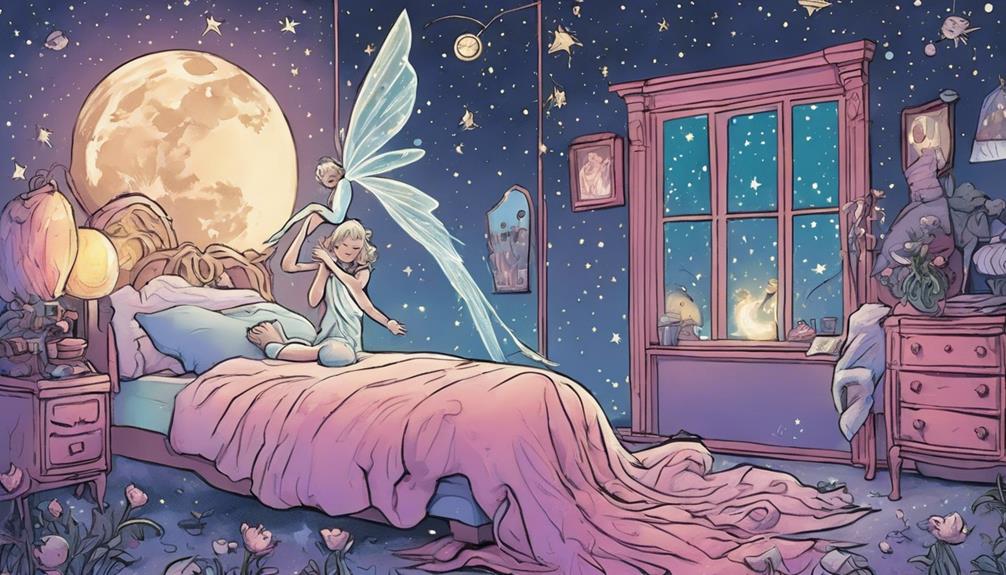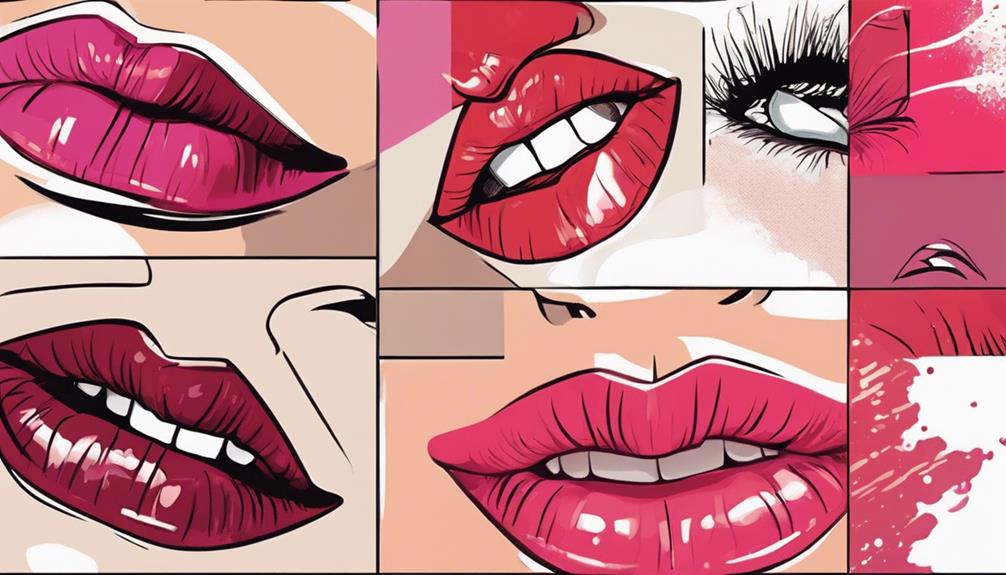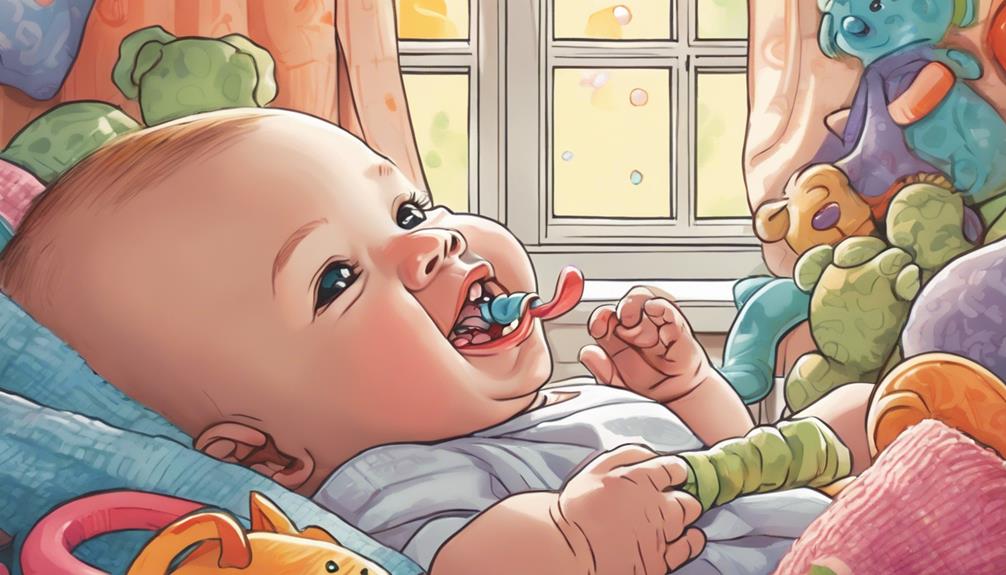When you place a lost tooth under your pillow, it starts a magical journey to the Tooth Fairy's castle. There, the Tooth Fairy collects your tooth and inspects it, preferring clean and shiny ones. Your tooth isn't just discarded; it's transformed into enchanting things like fairy dust or even stars twinkling in the night sky. Each tooth has a special purpose, contributing to the fairy's whimsical creations. Plus, you'll often find a little reward left behind as a thank you. If you're curious about the traditions and myths surrounding this enchanting tale, there's much more to discover!
Key Takeaways
- The Tooth Fairy collects lost teeth placed under pillows, ensuring a magical exchange for a reward.
- Collected teeth are taken to the Tooth Fairy's castle, where they are used for whimsical creations.
- Clean, cavity-free teeth are preferred and may be transformed into magical fairy dust for flights.
- Some collected teeth are kept to assist in the growth of new adult teeth.
The Tooth Fairy's Purpose

The Tooth Fairy's purpose is to create excitement around losing teeth by collecting them from under pillows and leaving behind money or small gifts. This enchanting tradition not only brings joy but also encourages you to prioritize oral health.
When you lose a tooth, you might wonder what the Tooth Fairy takes with her. Folklore suggests that the collected teeth are transformed into magical fairy dust or used to build whimsical castles, making the experience feel even more special.
As you embrace this tradition, it motivates you to maintain good dental hygiene. After all, cleaner, cavity-free teeth are believed to yield better rewards from the Tooth Fairy. The excitement of finding a coin or small gift in exchange for a lost tooth can help reinforce the importance of brushing, flossing, and visiting the dentist regularly.
While the average payout for a lost tooth has increased over the years, the essence of the Tooth Fairy remains the same: to celebrate this pivotal moment in childhood. This enchanting ritual highlights the universal theme of celebrating tooth loss, making it a cherished experience for kids everywhere.
The Journey of Lost Teeth

When you place your lost tooth under the pillow, you're setting off a magical journey that the Tooth Fairy initiates to collect and transform it into something extraordinary. During the night, she quietly visits your room, carefully retrieving your tooth in exchange for a small reward. This enchanting act not only brings excitement but also teaches you about the importance of dental health.
The Tooth Fairy prefers clean, shiny teeth that reflect good oral hygiene. If your lost tooth has cavities, she may choose to discard it. The teeth she collects often serve a greater purpose; some tales suggest they're transformed into fairy dust, enhancing her ability to fly and perform her magical duties.
As the Tooth Fairy gathers these cherished teeth, she adds them to her collection, contributing to the wondrous experience surrounding tooth loss. This journey helps you understand that losing teeth is a natural part of growing up, all while reinforcing the significance of taking care of your teeth.
The Tooth Fairy's Castle

Imagine the Tooth Fairy's castle, built from the shiny teeth she collects.
Each tooth, nestled in a golden bubble, tells a story about you and your healthy smiles.
With whimsical towers and sparkling moats, this magical domain showcases the beauty and care that goes into her unique tooth collection process.
Castle Structure and Design
Constructed from shiny teeth collected from children, the Tooth Fairy's castle sparkles with a whimsical charm that captivates the imagination. You can easily picture the fairies' castle standing tall with its enchanting towers and a shimmering moat surrounding it. Each tooth is carefully housed in a golden bubble, proudly displaying the child's name, making every tooth feel special and treasured.
The design of this magical structure emphasizes the importance of healthy teeth. Tooth fairies only collect teeth that are free from cavities, ensuring that only the best and brightest contribute to this magical castle. As you explore, you might notice that the walls glisten, reflecting light like stars in the night sky.
The belief that collected teeth could eventually transform into stars adds to the allure of the fairy's castle, making it a place of dreams and wonder. The attention to detail in the castle's design shows the care and respect the tooth fairies have for each child's lost tooth, creating a nurturing environment where memories are cherished.
It's more than just a castle; it's a celebration of childhood and the importance of dental hygiene.
Magical Tooth Collection Process
Every night, the Tooth Fairy delicately collects lost teeth from under pillows, ensuring that each one is transported safely in a golden bubble with the child's name. This magical process isn't just about taking teeth; it's a crucial part of her enchanting world.
Once they arrive at her castle, the Tooth Fairy inspects each child's tooth. Clean, cavity-free teeth are used to construct whimsical towers, while those with cavities are discarded, reminding kids of the importance of good dental hygiene.
As she collects teeth, they transform into magical fairy dust, fundamental for her flights across the night sky. This fairy dust fuels her adventures and keeps the magic alive.
- The golden bubbles keep teeth safe and sound.
- Cavity-free teeth are used for building her castle.
Through this delightful routine, the Tooth Fairy teaches children the value of taking care of their teeth. It's not just about the reward; it's about the journey from your pillow to her enchanting castle, where your child's tooth helps create something truly special.
Magical Uses for Collected Teeth

Collected teeth hold a special place in folklore, often believed to be transformed by the Tooth Fairy into whimsical structures, magical dust, and even twinkling stars in the night sky. When children lose their teeth, the Tooth Fairy collects them for various enchanting purposes.
Here's a glimpse into some magical uses for those collected teeth:
| Magical Use | Description |
|---|---|
| Whimsical Castles | Teeth are used to build fairy castles, showcasing the value of clean teeth. |
| Magical Fairy Dust | Some folklore suggests teeth are ground into fairy dust, helping fairies fly. |
| Necklaces and Ornaments | The Tooth Fairy may craft unique ornaments for her fairy friends from collected teeth. |
| Stars in the Night Sky | It's rumored that the brightest stars are actually lost teeth, shining down on children. |
| Aiding New Tooth Growth | Some teeth are kept to help babies grow new teeth, emphasizing oral health. |
The Tooth Fairy's Appearance

When you think about the Tooth Fairy, her enchanting appearance often comes to mind. You might picture her in a beautiful gown or a smart jumpsuit, with a friendly smile that reassures children during the tooth exchange.
Different cultures have their own takes on her looks, but the essence of a magical being remains a constant thread in these portrayals.
Common Depictions and Traits
The Tooth Fairy typically appears as a small, whimsical figure with wings, often resembling beloved fairytale characters like Tinkerbell. This enchanting character brings joy to children when they lose their milk teeth, transforming the experience into a magical moment. You might imagine her fluttering into your child's room, leaving behind a little surprise in exchange for that precious tooth.
Common depictions show the Tooth Fairy wearing beautiful gowns or smart jumpsuits, enhancing her mystical aura. She often has a cheerful smile, making her seem friendly and approachable. Here are some traits you might notice:
- Magical Wings: The Tooth Fairy's wings sparkle with fairy dust, suggesting her enchanting abilities.
- Endearing Attire: Her outfits are often adorned with glitter or flowers, appealing to children's imaginations.
These delightful traits make the Tooth Fairy an unforgettable figure in every child's journey of growing up. So, when your little one loses a tooth, you can remind them of the magic that awaits!
Cultural Variations in Appearance
Across cultures, the Tooth Fairy's appearance varies considerably, reflecting unique traditions and local folklore that shape children's experiences with losing their teeth.
In many places, you might picture the Tooth Fairy as a small, winged creature, similar to Tinkerbell, adorned in colorful gowns or smart jumpsuits. Her friendly smile captures the hearts of children, making the experience feel magical.
However, in Spain and parts of South America, the Tooth Fairy takes on a different form. Here, children look for the 'Ratoncito Pérez' or 'El Ratón de los Dientes,' a charming mouse that collects their lost teeth. These cultural variations highlight how the Tooth Fairy adapts to local traditions while maintaining her role as a magical figure.
Some stories even portray the Tooth Fairy as resembling the child's parents, creating a comforting connection during this changing moment.
Regardless of her appearance—whether she's a whimsical fairy or a friendly mouse—the core theme remains: a magical being rewards children for their lost teeth, fostering excitement and a sense of tradition.
It's a beautiful reminder of how cultural interpretations enrich the experience of losing teeth.
Symbolism and Significance
Cultural variations in the Tooth Fairy's appearance reveal deeper symbolism and significance, highlighting how this enchanting figure represents comfort, joy, and the magical aspects of childhood.
You might picture the Tooth Fairy as a tiny, winged creature adorned in beautiful gowns, reminiscent of Tinkerbell. This whimsical portrayal embodies the innocence of childhood and serves as a soothing presence during the sometimes anxious experience of losing a child's teeth.
The Tooth Fairy brings:
- Joy and positivity: Her smiling face encourages good oral hygiene and a positive outlook on growing up.
- Familial connection: In some cultures, she resembles a child's parents, reinforcing the bond during this developmental phase.
This charming figure not only makes losing teeth exciting but also teaches children that growing up can be a delightful journey filled with magic and wonder.
The Tooth Fairy's presence transforms a simple act into a cherished memory, encouraging children to embrace change with a smile.
Rewards From the Tooth Fairy

Kids enthusiastically anticipate rewards from the Tooth Fairy, with the average payout now reaching $3.70 per tooth. This amount of money has increased considerably over the years, reflecting the joy and excitement of losing those first teeth. In some regions, the Tooth Fairy leaves even more, making it a thrilling experience for children.
Many families enhance this magical moment by using unique tooth holders or leaving special notes. Here's a glimpse of average payouts across different regions:
| Region | Average Payout |
|---|---|
| Northeastern US | $4.10 |
| Southeastern US | $3.50 |
| Midwestern US | $3.30 |
| Western US | $3.80 |
The Tooth Fairy not only rewards kids but also recycles the teeth, creating a delightful tradition. Some families even choose to give gifts instead of cash, adding a personal touch to the experience. Glitter-covered bills or coins can serve as cherished keepsakes, making the moment even more memorable. This enchanting ritual guarantees that losing a tooth becomes a celebration!
Global Tooth Fairy Traditions

Different countries celebrate the tradition of losing teeth in unique ways, with their own characters and customs that add magic to the experience. While you might be familiar with the tooth fairy who leaves gifts for your baby teeth, other cultures have their own enchanting figures and rituals.
In Spain and many Spanish-speaking countries, a mouse known as 'El Ratón de los Dientes' takes lost teeth and leaves behind a small gift or money.
In Turkey, children bury their baby teeth in the ground, believing it brings good luck and guarantees strong adult teeth.
In some Asian cultures, kids toss their upper teeth onto the roof and bury their lower teeth, wishing for healthy new teeth.
These diverse traditions show how losing baby teeth is celebrated around the world. Whether it's a mouse or a fairy, the excitement remains the same as children excitedly anticipate a special gift.
Promoting Dental Health

Celebrating the magic of losing teeth can also be a great opportunity to instill good dental habits in children, laying the foundation for a lifetime of healthy smiles. The Tooth Fairy tradition makes it fun for kids to care for their baby teeth, reinforcing the importance of oral hygiene.
To guarantee your child develops a positive attitude towards dental health, focus on three key areas:
| Action | Benefit | Tip |
|---|---|---|
| Regular Check-ups | Early detection of dental issues | Schedule visits every six months |
| Proper Brushing | Reduces cavities and gum disease | Teach proper techniques and timing |
| Encourage Flossing | Maintains healthy gums | Make it a fun daily routine |
The Tooth Fairy Myth Explored

The enchanting tale of the Tooth Fairy captivates children and parents alike, sparking excitement and curiosity about the magical exchange that occurs when a lost tooth is placed under the pillow.
As your little one loses a tooth, they enthusiastically anticipate a visit from this mythical figure, who rewards them for their baby teeth with coins or small gifts. This tradition not only highlights the joy of losing a tooth but also reinforces the importance of dental hygiene.
Here are some fun aspects of the Tooth Fairy myth:
- Cultural Variations: Different cultures have their own unique tooth-collecting characters, like the Tooth Mouse in Spain.
- Economic Trends: Today, the average payout for a tooth has risen to about $3.70, with some lucky kids receiving as much as $20 for their first lost tooth!
Ultimately, the Tooth Fairy is a whimsical way to celebrate the journey of growing up, making losing a tooth a cherished milestone in your child's life.
Frequently Asked Questions
Where to Put a Tooth for a Tooth Fairy?
You should place your tooth under your pillow, making it easy for the Tooth Fairy to find. Consider using a special tooth pillow or bag for an extra magical touch during her nightly visit.
Does a Tooth Fairy Take the Tooth Away?
Yes, the Tooth Fairy does take the tooth away. When you place it under your pillow, she magically collects it while leaving a coin or gift in exchange, making losing teeth an exciting experience for you.
What Does the Tooth Fairy Do With Everyone's Teeth?
Did you know about 300 million teeth are collected annually by the Tooth Fairy? She repurposes them into magical dust, sparkling jewelry, or even transforms them into stars, blending whimsy and creativity into her enchanting world.
What Do the Children in Other Countries Do When They Lose Their First Tooth?
When you lose a tooth, kids around the world celebrate differently. In Spain, you leave it for a mouse, while in Turkey, you toss it on the roof for luck. Each culture has unique customs!
What Happens to the Teeth Once the Tooth Fairy Takes Them?
Have you ever wondered where tooth fairy takes teeth once she collects them from under your pillow? Some say she uses them to build her sparkling white castle, while others believe she recycles them to create new baby teeth. The truth remains a mystery, tucked away in the nocturnal realm of the tooth fairy. One thing is for certain, tooth fairy traditions vary around the world. In some cultures, the tooth fairy doesn’t take the teeth at all, but instead leaves a small gift or coin in exchange. Whether she uses the teeth for construction, recycling, or something entirely different, the magic and mystery of the tooth fairy continues to capture the imagination of children and adults alike.
Conclusion
So, next time you tuck your lost tooth under your pillow, remember the enchanting journey it takes to the Tooth Fairy's castle.
Coincidentally, while you're dreaming of magical domains, your tooth might just be transformed into something extraordinary, promoting dental health around the world.
As you wake up to a little surprise, it's a sweet reminder that the myth isn't just about rewards; it's also about sparking joy and curiosity in every child's heart.








